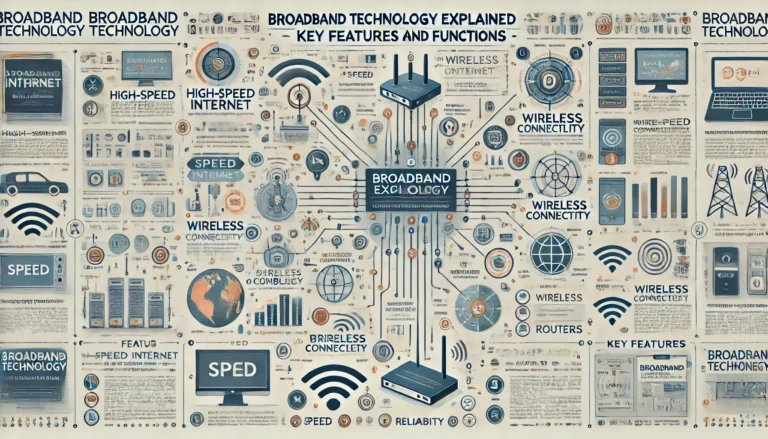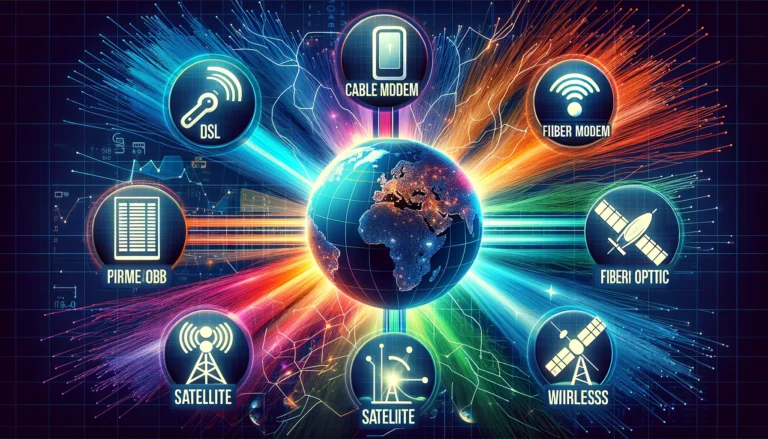Broadband Technology 101: Everything You Need to Know
Understanding the Basics of High-Speed Internet Access
To start with, let’s demystify the term “broadband.” Broadband refers to high-speed internet access that is faster and more reliable than traditional dial-up access. It provides a wide band of frequencies and allows large amounts of data to be sent or received simultaneously. This technology is not confined to a single method but can be delivered through various mediums such as digital subscriber lines (DSL), cable modems, high-speed fiber optics, satellite, wireless connections, and more. Transitioning on from the basic definition, broadband technologies have significantly evolved over the years. Initially, users primarily accessed internet via dial-up connections which were slow and required the phone line to be occupied for the duration of use. However, with broadband technology, users can enjoy high speed internet while simultaneously using their telephone lines. Moreover, broadband has enabled a host of services like video conferencing, streaming television and interactive gaming which demand substantial bandwidth. Henceforth, it’s safe to say that broadband has revolutionized the way we communicate and consume media today. Without resorting to a formal conclusion, it’s worth understanding how integral broadband technology is in our everyday lives. It plays a pivotal role in connecting individuals globally by providing swift communication channels. Furthermore, in this digital age where everything from business operations to entertainment relies heavily on internet connectivity, having access to reliable and fast broadband service is no longer a luxury but rather a necessity. The future promises even greater advancements in this field with emerging technologies such as 5G aiming at providing unprecedented speeds and reliability.

The Evolution and History of Broadband
Delving into the past, the evolution of broadband technology can be traced back to the late 1990s. At this point in time, most individuals were using dial-up connections, which were not just slow but also occupied the phone line for their duration of use. This meant that every time someone wanted to access the internet, they couldn’t use their landline telephone. It was during this era that broadband was introduced as a new and improved way of connecting to the internet. Moving onto the next phase of evolution, broadband technology began to take off in the early 2000s with DSL (Digital Subscriber Line) and cable modems becoming more commonplace. These technologies offered significantly higher speeds compared to traditional dial-up connections and did not require exclusive use of a phone line. As a result, users could make phone calls and browse the internet simultaneously – an aspect that heavily contributed towards its popularity. As we progress into recent years, we see an even greater leap in broadband technology with the introduction of fiber-optic connections. Offering unparalleled speed and reliability, this form of broadband has become increasingly popular among businesses and households alike. Moreover, wireless broadband technologies have emerged as well, enabling users to access high-speed internet without being tethered by cables or wires. Without summarizing or drawing conclusions yet, it’s clear that advancements in broadband technology have been rapid and transformative over the years. The trajectory indicates an exciting future ahead with potential developments such as 5G on the horizon promising unprecedented speeds and connectivity options.
Different Types of Broadband Connections
Understanding the different types of broadband connections is crucial to navigating the world of high-speed internet. Essentially, there are four primary forms of broadband connections: DSL, Cable, Fiber-Optic, and Wireless. DSL (Digital Subscriber Line) is a type of broadband connection that uses existing telephone lines for data transmission. This technology provides internet services via a direct line from the service provider to the consumer’s home or office. As mentioned earlier, one significant advantage of DSL over traditional dial-up connections is that it allows simultaneous use of the phone and internet. However, the quality and speed of DSL can vary depending on your proximity to the service provider. Next up is Cable broadband which uses coaxial cables initially designed for cable television to deliver high-speed internet. Typically faster than DSL, cable broadband offers a shared connection among users in a particular area. This could mean that during peak usage times when many people are online, you may experience slower speeds. Conversely, fiber-optic broadband is currently the fastest available technology for delivering high-speed Internet. It operates by transmitting data as pulses of light through specially designed glass or plastic fibers. Unlike DSL and Cable, Fiber-optic doesn’t suffer from degradation over distance and offers much higher speeds. Lastly, we have wireless or Wi-Fi broadband which has become increasingly prevalent in recent years due to its convenience and ease-of-use. As its name suggests, this form of broadband delivers high-speed Internet without needing any wires or physical connections. Instead, data is transmitted via radio signals between your device and a nearby wireless router. Wireless networks can be found in homes, businesses, and public spaces like cafes or libraries making it an incredibly flexible option. Whether you’re after speed or convenience will influence which type of broadband connection suits your needs best.
Insight into Fiber Optic Technology
To understand fiber optic technology, it’s crucial to dive into its mechanics. Fiber-optic broadband leverages a unique method of data transmission that sets it apart from other types of broadband connections. As mentioned earlier, unlike DSL and Cable, this technology uses pulses of light to transmit information through specialized strands of glass or plastic fibers. The data is converted into light signals, sent down the fiber optic cable, and then converted back into conventional electrical signals at the other end. Transitioning to another aspect, the speed and reliability of fiber optic connections are exceptional due to their unique transmission method. One noteworthy advantage is that they do not suffer signal degradation over long distances like DSL or Cable. This feature makes them ideal for use in vast network systems spanning cities or even continents. Furthermore, these connections can deliver incredibly high speeds – up to 1 Gbps (gigabit per second) or more in some cases – which significantly outpaces other forms of broadband. We also need to consider the future implications of this technology. Fiber optics hold an exciting potential for further advancements in internet connectivity and telecommunications as a whole. With increasing reliance on digital platforms for everything from work to entertainment and socializing, the demand for higher-speed and more reliable internet is only set to grow. Fiber-optic broadband stands at the forefront of meeting this demand with its unparalleled speed and consistency. Its potential isn’t just limited to improving internet speeds; there’s also promising scope in fields like healthcare, education, infrastructure management, and even environmental monitoring where high-speed data transfer is critical.
Wireless Connectivity: Wi-Fi, Satellite, and Mobile Networks
Shifting our focus from land-based broadband connections, let’s delve into the domain of wireless connectivity. The most familiar form of this technology is Wi-Fi, a ubiquitous feature in homes and businesses around the globe. Unlike wired broadband connections, Wi-Fi enables data transmission over air waves, eliminating the need for physical cables. Typical Wi-Fi setups involve a router that acts as an access point, connecting multiple devices to the internet simultaneously using radio signals. Apart from Wi-Fi, there are two other significant types of wireless connectivity: satellite and mobile networks. Satellite internet works by bouncing signals off a satellite orbiting the earth. This technology is particularly useful in remote areas where traditional broadband infrastructure might be lacking or non-existent. On the downside, latency issues can sometimes affect satellite connections due to the immense distances involved in transmitting signals to and from space. Mobile networks, on the other hand, leverage cellular technology to provide internet access. This means that wherever you have mobile coverage, you can also potentially have an internet connection. With advancements such as 4G and now 5G technology, mobile networks offer increasingly competitive speeds that rival some forms of fixed-line broadband. However, it’s worth noting that factors like signal strength and network congestion can significantly influence this type of connection’s performance and reliability. As we continue seeing technological advancements in these areas – especially with efforts towards global 5G deployment – wireless connectivity is poised to play an even more integral role in our digitally connected lives.
Benefits of Using High-Speed Internet Services
High-speed internet services have become a crucial part of our daily lives. They allow us to stay connected, access information, and engage in digital activities with ease and convenience. Whether it’s streaming high-definition videos, engaging in online gaming, telecommuting for work, or simply keeping up with social media feeds – all these activities are made possible through the power of high-speed internet. With fast download and upload speeds at your disposal, you can seamlessly surf the web without any interruptions or delays. In addition to speed, high-speed internet also offers greater reliability compared to slower connections. This is particularly significant when it comes to tasks that require uninterrupted connectivity and consistent speed. For instance, during video conferencing calls – a common fixture in today’s remote working environment – a stable connection with high bandwidth is vital to ensure smooth communication. Also, if you share your internet connection with multiple devices at home, having a high-speed internet service can prevent network congestion and ensure everyone gets their fair share of bandwidth. Moreover, investing in high-speed internet services can also be economically beneficial in the long run. While higher speeds often come with higher monthly bills, they also tend to offer better value for money considering the performance benefits they bring along. For example, if you’re using cloud-based applications or services frequently such as Google Drive or Dropbox for work purposes, faster upload speeds would mean less time waiting for files to sync and more productivity during your work hours. Thus, while on the surface it may seem costly; ultimately these services pay off by increasing efficiency and productivity over time.
Challenges and Limitations in Broadband Deployment
Broadband deployment, while beneficial, does come with its own set of challenges and limitations. One major hurdle faced globally is the issue of accessibility. Not every region, especially in rural or remote areas, has the infrastructure needed for broadband connectivity. These ‘digital deserts’ are often left behind due to the high cost of laying cables and setting up necessary equipment in such locations. The digital divide thus created not only impacts individuals’ access to information but also affects economic growth and development opportunities. Moreover, even when infrastructure is present, affordability poses a significant barrier for many users. While high-speed internet services offer greater value for money in terms of speed and reliability, they also typically come with a higher price tag. For low-income households or those living in developing countries, these costs can be prohibitive – thereby limiting their ability to fully participate in today’s digital society. Another challenge lies in maintaining quality service amidst growing demand. As more devices get connected and as we continue to rely heavily on online platforms for various activities – from work to education to entertainment – the pressure on broadband networks increases exponentially. Service providers must constantly upgrade their systems and expand capacity to ensure consistent performance. Failing to do so can lead to network congestion, slower speeds and unsatisfied customers. This need for constant innovation and adaptation adds another layer of complexity to the overall process of broadband deployment.
Role of Broadband in Digital Transformation
Broadband technology plays a pivotal role in the worldwide digital transformation we’re currently experiencing. As a key enabler of high-speed internet access, it forms the backbone for many digital services we use today. Whether it’s streaming our favorite shows, participating in an online class, or managing a remote workforce, broadband is at the heart of it all. Its importance in driving digital innovation and inclusivity cannot be overstated. In addition to facilitating routine activities, broadband also empowers transformative technologies that are shaping our future. Think about the Internet of Things (IoT), cloud computing, artificial intelligence (AI), and telemedicine – all these innovations rely heavily on robust and reliable broadband connections for their functionality. Without high-speed internet access, these technological advancements would remain largely inaccessible and ineffective. Hence, broadband technology can indeed be considered as a cornerstone of contemporary digital transformation. Moreover, broadband plays an instrumental role in improving socio-economic conditions. By enabling e-learning platforms, it promotes education in remote areas where traditional learning methods might not reach. Similarly, telemedicine allows medical professionals to diagnose and treat patients remotely – a boon especially during pandemic situations like Covid-19 when physical distancing is paramount but healthcare needs continue unabatedly. In essence, by catalyzing digital connectivity and accessibility across different sectors and regions, broadband acts as a catalyst for comprehensive societal progress and development without explicitly signaling its conclusion.
Enhancing your Online Experience: Tips for Optimal Broadband Usage
As we have established, the role of broadband technology in our digital lives is undeniable. But how can you ensure you are making the most of your broadband connection to enhance your online experience? It all starts with understanding what kind of user you are. Are you a casual browser, a hardcore gamer, or maybe a remote worker relying on seamless video conferencing? Each scenario requires different bandwidth and speed requirements, so it’s crucial to match your broadband plan with your specific needs. Now, let’s delve into some practical tips to optimize your broadband usage. A key aspect is regularly testing your internet speeds using online tools like Ookla’s Speedtest or Fast.com. These tests will help you monitor if you’re actually getting the speed promised by your ISP (Internet Service Provider). If the results consistently fall short, it might be time for a discussion with your provider or even consider switching services. Another vital factor is ensuring that your home network setup is optimized for best performance. This includes positioning your router in an open central location away from electronic devices that may cause interference and regularly updating firmware and software for optimal functionality. Also, upgrading hardware like modems and routers every few years can help keep up with advancements in broadband technology. On the other hand, if multiple users are sharing one connection at peak hours, this could slow down internet speeds significantly. To manage this issue better, consider scheduling heavy downloads/uploads during off-peak times when fewer users are connected to the network. In essence, mindful management of these aspects can significantly enhance your overall online experience without explicitly suggesting an end point.
Future Trends and Developments in High-Speed Internet Technology
As we continue to venture deeper into the 21st century, the demand for high-speed internet continues to soar. This is due in part to our increased reliance on digital platforms for communication, work, and entertainment. This trend has accelerated developments in broadband technology with many exciting innovations on the horizon. These advancements are not only expected to improve the speed and reliability of internet connections but also expand coverage areas and introduce new ways of accessing the internet. One notable trend that’s reshaping high-speed internet technology is the advent of 5G networks. The fifth-generation technology standard for cellular networks promises unprecedented speeds that outpace current 4G and LTE networks significantly. Beyond speed, 5G is poised to reduce latency dramatically, making real-time applications like online gaming and video conferencing smoother than ever before. It also facilitates a more efficient Internet of Things (IoT), allowing an explosion of connected devices from smart home appliances to autonomous vehicles, all communicating seamlessly. Another prominent development in this space is satellite broadband technology. Companies like SpaceX’s Starlink are launching thousands of small satellites into low Earth orbit (LEO) to provide fast, reliable broadband service worldwide – including remote and rural areas traditionally underserved by terrestrial ISPs. This approach could be a game-changer in bridging the digital divide across various regions globally. While these advancements paint a promising picture of what’s next in high-speed internet technology, it’s important to note that they will require significant infrastructure investments and regulatory approvals before becoming widely available.






